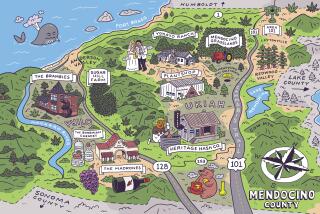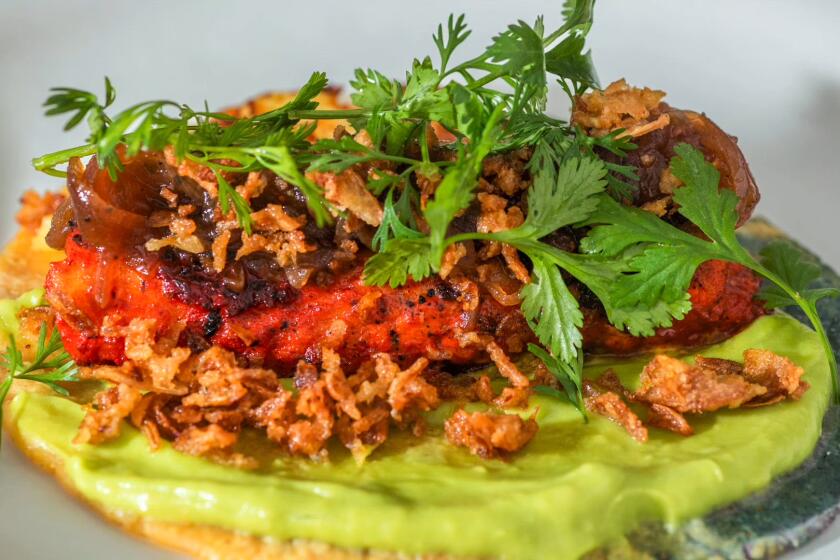Glory Grows in a Patch of Desert
It is barely more than a green streak across the shoulder of a barren ridge. But that small swath of vines makes up Washington’s newest appellation, and it is the source of some of the state’s most extraordinary wines.
It is called Red Mountain. And while the “mountain” part is a bit of an exaggeration--it is, after all, the state’s smallest appellation--the area is rich in reds. Cabernet Sauvignon, Merlot and Syrah all thrive in this eastern desert environment.
Established in 2001, Red Mountain is home to only a few wineries, notably Terra Blanca, Hedges and Kiona. The area’s cachet is largely based on the reputation its fruit has gained among wine producers beginning with the first crop in 1977. McCrea Cellars, Andrew Will, L’Ecole No. 41, Canoe Ridge, DeLille Cellars and Betz Family Winery are just a few names on the lengthening roster of wineries offering Red Mountain-designated wines.
Red wines made from Red Mountain grapes are intense and structured, larger than life. They can have an almost withering intensity, like Terra Blanca Syrah, or be relatively gracious, like Kiona’s fine-grained Cabernet Sauvignon, but their signature--perfectly exemplified by Hedges Cellars Red Mountain Reserve, a Cabernet-Merlot blend--is monumental depth and structure with almost uncannily precise definition on the palate.
More like a sagging butte than a mountain, Red Mountain is one of several free-standing ridges that were once part of a single long ridge. It was formed as an anticline, or uplifted fold in the earth’s crust created by plate tectonics. The longest part of the fold is called Rattlesnake Mountain. Red Mountain, Badger Mountain, Goose Hill and several other detached segments are known as the Rattles.
The hills are separated by channels cut over time by the meandering Yakima River. Red Mountain’s 710 acres of vines within a small AVA area of about 4,000 acres, facing the megalithic Horse Heaven Hills southwest across the Yakima’s present course, are perfectly situated to benefit from weather moving up the valley: heat-tempering marine winds flowing where the waters once moved.
Aside from the riparian green along the Yakima and its tributaries, the country is arid. Summer nights are often lit by wildfires moving across vast slopes of dry grassland. Rainfall averages a scant 6 inches during the growing season, compared with 14 in the Walla Walla Valley, just a 45-minute drive southeast.
Mountain Versus Valley
Red Mountain wines play a nice counterpoint to those from the Walla Walla Valley. To put it another way, a typical Red Mountain red wine is an elegant version of big, while a typical Walla Walla red wine is a big version of elegant. Both appellations are growing grapes in a desert, but with plenty of irrigation. And both are subject to an extreme climate, but in a situation where the extremes are moderated at a distance by a marine influence.
The Red Mountain winegrowers are working on a remarkable viticultural platform. The region’s landforms were arranged in the not-so-distant past by a long series of cataclysmic floods of a volume and ferocity impossible to grasp fully. The simple facts alone tell an awesome tale: Over the course of thousands of years, at least 40 floods submerged some 16,000 square miles under hundreds of feet of water. At times the site of present-day Portland, Ore., was 400 feet deep.
From a plane or helicopter it’s not hard to pick out vast areas of ripple-like ridges and meandering channels that look like the intertidal zone on a sandy beach. That’s what geologist J. Harlen Bretz saw in the first decades of the 20th century.
“These remarkable records of running water on the Columbia Plateau and in the valleys of Snake and Columbia rivers cannot be interpreted in terms of ordinary river action and ordinary valley development,” wrote Bretz in one of his many academic papers on the subject. “Enormous volume, existing for a very short time, alone will account for their existence.”
The floodwaters transported more than 50 cubic miles of soil and rock from as far as Montana, including 200-ton boulders carried in floating chunks of glacial ice. Those materials were deposited, arranged and rearranged into a variety of landforms--some of them ideal for growing grapes.
The materials were deposited a little differently in the two future appellations. The Walla Walla Valley trapped the water, allowing sediment to filter down in orderly layers. The ridge of which Red Mountain was a part formed an obstacle to the floods, so that soil and rock were deposited more violently and randomly by swirling, sloshing waters. Between the floods (which occurred roughly twice a century), windblown volcanic materials, mostly a fine-textured loam called loess, were laid over the flood deposits.
“It’s a layer cake,” explains Terra Blanca founder Keith Pilgrim. “You have fine sand and silt layered with cobbles ranging from marble size to Buick size. A lot of them are coated with calcium carbonate. And that high-carbonate soil has a signature, a chalkiness on the back of the palate. Once you taste it, you’ll pick out Red Mountain wine from here on out.”
Perhaps; that’s the kind of character that becomes clear only over time. There’s certainly a distinctive high-toned earthiness and fine texture behind the vibrant blueberry and black fruit flavors in Terra Blanca Merlot, and the same quality can be detected in the darkly herbaceous flavor in Onyx, Bordeaux-style blend.
Grower Jim Holmes, a former research engineer, planted the first vines on Red Mountain in 1975, when land was $200 an acre.
“There were no fences, houses, or roads,” he recalls. “No power. We were off the grid.”
He and his partner, John Williams, called the vineyard Kiona. In 1980 they made the first Kiona wines in Holmes’ garage in nearby West Richland. They subsequently split the business. Williams took Kiona, and his son, Scott, is now in charge of the vineyard and wines.
Holmes took the original vineyard, called Ciel du Cheval (“horse heaven”), which he continued to expand. Among several other varieties, he planted Syrah in 1994, at the same time that Pilgrim was planting Syrah on the nearby Terra Blanca estate. Ciel du Cheval is now about 120 acres.
DeLille Cellars buys Ciel du Cheval grapes for “Doyenne” Syrah, a massive yet elegant red. DeLille founder Chris Upchurch notes, “Lots of places make big, rich red wines. But not many have this kind of balance, the velvet hammer effect.”
A Glimpse of the Future
Red Mountain’s full potential has yet to be revealed. Clues to the future are gradually being revealed by experimental plantings such as the two-acre plot at Terra Blanca, where multiple clones of such varieties as Tempranillo, Sangiovese, Nebbiolo and Dolcetto grow side by side.
“Washington is a young growing region,” says Pilgrim, “and one of the things to be determined is which grapes work best in which locations.”
A treat is in store for wine fans--we can all taste along as Red Mountain continues to emerge.
More to Read
Eat your way across L.A.
Get our weekly Tasting Notes newsletter for reviews, news and more.
You may occasionally receive promotional content from the Los Angeles Times.










